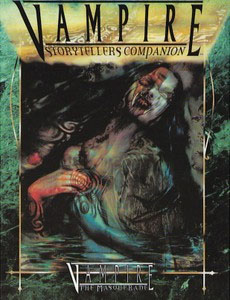Tagline: If you’re the type that likes GM screens or interesting tidbits of knowledge concerning the World of Darkness, this product will probably be a satisfying purchase.
 The Storyteller’s Screen and the accompanying Storyteller’s Companion are both very good products for what they are, but there’s nothing particularly exciting or innovative about either – nor do I consider them crucial products to the gaming experience. Surely with the plethora of materials available for the Vampire game you should be able to find something else worth spending fifteen dollars for.
The Storyteller’s Screen and the accompanying Storyteller’s Companion are both very good products for what they are, but there’s nothing particularly exciting or innovative about either – nor do I consider them crucial products to the gaming experience. Surely with the plethora of materials available for the Vampire game you should be able to find something else worth spending fifteen dollars for.
The Storyteller’s Screen is made up of four 8” x 11” panels. The GM’s side has: A list of the five traditions, the armor chart, a chart summarizing the thirteen generations, a summary of aura colors, a hierarchy of human sin, a blood pool chart, a combat maneuver chart, a chart for judging feats of strength, two weapons charts, a combat summary chart, an experience chart, a summary of difficulties, a summary of hunting, damage charts for fire and sunlight, plus a general health chart and a summary of various vehicle types. This is an impressive array of information, and I found it was generally useful. I was also impressed that White Wolf avoided the temptation of including a summary of character generation on the screen – something almost every GM’s screen seems to possess despite the very obvious fact that you will never, ever need to access that information in the course of actual gameplay.
The opposite side of the screen is a very nice mosaic comprised of various vampires looking either threateningly or seductively out at you. I found it be an excellent choice of art because the choice of colors meant that it wasn’t overly distracting, but at the same time it was not so monotonous as to become easily boring to look at after a short time. In general, if you’re into GM’s screens this one is extremely admirable.
The accompanying book – the Storyteller’s Companion — on the other hand, cannot be so lauded. This is your typical hodgepodge of material thrown together so that the GM’s screens doesn’t have to stand on its own. Included are three new bloodlines (the Daughters of Cacophony, the Salubri, and the Salmedi) along with their associated disciplines. There’s also an extensive list of new equipment and an expanded character sheet. All in all, fairly boring stuff in my opinion which could have been more effectively integrated into other products instead of being thrown together without any sense of clear purpose here.
The most useless section in the book, however, would be Secondary Abilities. These are a new set of rules meant to supplement the Primary Abilities found in the main rulebook. In general I saw little differential between these abilities and those in the rulebook (why, for example, they felt that Interrogation would be used less often (and therefore qualify as a secondary ability) than Performance (a primary ability from the main rulebook) is beyond me), but these secondary abilities are cheaper and subject to a slightly different set of rules. The net result, as the book itself says, is that these “Secondary Abilities add greater complexity to the game, but they also add greater complication” (you’ll note that the words “complexity” and “complication” can be seamlessly interchanged here). Nothing is really accomplished by their inclusion except unnecessary headaches. Personally if I were to use any of them I would treat them exactly as I treat Primary Abilities. It should also be noted that since the expanded character sheet takes these Secondary Abilities into account, the other nice features of the character sheet (an expanded background and history section) are rendered rather useless. Oh well.
In general I found the product uninspiring, although generally adequate for this type of thing.
Style: 4
Substance: 3
Author: Clayton Oliver
Company/Publisher: White Wolf
Cost: $14.95
Page count: 70
ISBN: 1-56504-259-9
Originally Posted: 1999/02/17
One of the weird things about getting comp material for review is the essentially random nature of what you end up reviewing. You also end up reviewing stuff that you would never have actually bought for yourself, which creates a strange dynamic in which it becomes difficult to accurately judge the value of the material for people who actually are the target market. (Of course, one of the skills of a good reviewer is the ability to step out of your own shoes to judge the material as objectively as possible… while remembering that objectivity doesn’t mean relativity.)
In other news: Landscape screens are awesome and I’m not sure how we ever endured the taller screens of yore. I have also just realized that it’s been over ten years since I last played Vampire. That makes me a little sad.
For an explanation of where these reviews came from and why you can no longer find them at RPGNet, click here.











